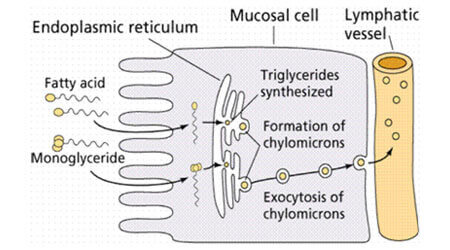Absorption of Fats
Generally, the fats are not soluble in the water, and due to this reason, their digestion is much difficult. They are hydrophobic in nature so they clump together and make the large droplets, as it moves through the digestive system. By some time, these fats reach the small intestine with no digestion. So, in the small intestine, the dietary fats look like the large globule of the fat. Until the production of bile in the liver, these fats remain undigested. The bile causes the emulsification of the fats, as it contains the salt that acts as the emulsifier for the lipids. By the emulsification, the large particles of fats are broken to the smaller droplets.

There is only one fat cholesterol that is absorbed by the human intestine. It is also found in animal fats. In combination with the bile salts and the cholesterol esters, it is absorbed in the lymph. The vitamin D that is the sterol derivative is also absorbed. For the absorption of the fats, the key processes of breaking them into smaller particles should occur. Larger aggregates which are insoluble in the aqueous environment should be physically broken down and held in the suspension by the process of emulsification.
Assimilation of Fats
The fat deposits of the body serve as reserves for the storage of the fats, such as the mesenteries and the subcutaneous layers, etc. For other cells, the stored fat is the readily available source of the fuel. The stored fat has important insulation properties and helps to maintain body temperature. Additionally, it also helps in the conservation of heat. It also has a protective role for the packaging and filling of materials and helps the body organs to be apart from each other by producing a layer between them. Phospholipids are produced in the liver and when they are returned to the blood, they can be used by all of the cells.
Conversion of Stored Fats for Yielding Energy
The fats are converted to the carbohydrates and amino acids in the liver cells. The stored fat is a good compound as its release can give twice the energy than the energy released by the carbohydrates in their respiration. Assimilated fats also serve as insulators for the skin. Fat is also used by the nerve cells to form the myelin sheath for preventing the leakage of the electrical impulses.